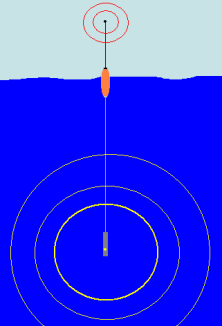 |
A typical
sonar system works by emitting ultrasonic pulses from an acoustic projector.
A sensitive microphone, or hydrophone, listens and analyzes the signal
that was reflected off a submarine or obstacle. There are three main types
of sonar: active, passive, and acoustic communication systems.
Passive sonar systems are made of sensors that receive the noise made by an object, generally a submarine or surface ship. Since passive sonar does not create any sound, it is primarily used in submarines. The sound waves are analyzed to find the type of ship and identify its direction, distance, and speed. Other objects can also be detected such as certain species of whale that produce distinct patterns of sound. Passive projectors are usually deployed from sonobuoys (hydrophone mounted in floating buoy), towed behind a ship, or mounted on a ship's hull. Sometimes, buoys may also be laid on the ocean floor, but the most advanced system, called a towed array, uses a long cable on which hydrophones are attached. The disadvantage to passive sonar is that it cannot detect the range. An estimate can be calculated by measuring the curvature of the received sound wave. |